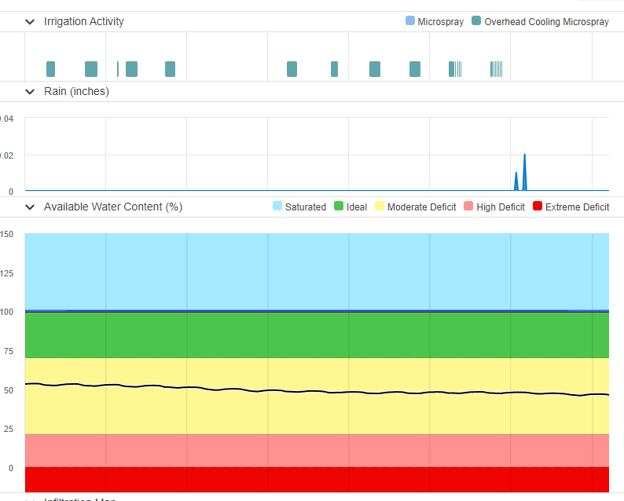Maximizing Water Efficiency: Differentiating Cooling Strategies from Irrigation Methods
Water is water, right? Actually, depending on how the water is applied, water counts differently towards irrigation.
In this blog post, we will explore cooling strategies and irrigation methods - overhead cooling vs. micro spray or drip irrigation - and discuss how they differ and impact soil moisture.
Understanding these distinctions will help you make informed decisions about your irrigation practices and help you optimize water usage in your orchard or field.
Overhead Cooling Strategies
Overhead cooling serves two purposes:
- To cool the temperature of the plants the water touches
- To remove heat from surfaces and the air to provide more ideal temperatures for maturing fruits
However, the majority of this water evaporates shortly after contact, resulting in minimal penetration into the soil.
Because of this, you can’t count on overhead cooling strategies to provide irrigation as well as cooling. Most of the water never makes it more than an inch or two into the ground. It may feel like you are applying a lot of water, but remember the purpose of that water is for cooling, not irrigation.
Be sure to watch your soil moisture and apply irrigation water as needed.

Example of how the soil moisture in an orchard remained unaffected by the use of overhead cooling strategies. The top graph "Irrigation Activity" shows when overhead cooling microsprays were applied. The bottom graph "Available Water Content" shows how the soil moisture remains unaffected over the same time period.
Irrigation Methods
Many orchards use both micro spray systems and drip systems to irrigate their fields. How do they differ and when should you use one over the other?
1. Micro Spray Irrigation
Micro spray irrigation systems emit more water per hour and cover a greater proportion of the orchard floor compared to drip emitters. Even though they put out more water, micro spray systems often irrigate up to 75% more surface area than drip emitters, so it takes longer to move water deep into the soil.
Growers often wonder why a six-hour micro spray irrigation doesn’t register the same as a six-hour drip irrigation. It's simply because it's spread out across so much land. To achieve similar water penetration, longer irrigation times may be necessary when using micro sprays.
Micro sprays are beneficial for watering cover crops situated between rows, as the roots of dwarfed tree varieties are concentrated near the tree's canopy.
However, for the dwarfed tree varieties themselves, which have small canopies and root systems, micro spray irrigation is generally unnecessary.
2. Drip Irrigation
Drip irrigation is especially effective and efficient for the small, dwarfed trees commonly found in orchards today.
Drip systems apply water right where the roots are without losing much to evaporation. Double-line drip is just as effective on full-sized trees. Not only does it apply water where it is needed, but trees are also able to adapt their root zone to fit in the wetted areas drippers create.
Keep in mind though, that small root zones mean that trees are pulling from a small area of soil. It is almost as if they are in a pot, even though they are planted in a field. You have to treat that pot with care by applying appropriate nutrients and water right where it is needed.
Conclusion
Understanding the advantages and limitations of each of these irrigation methods and cooling strategies is crucial for efficient water usage and successful crop growth. Here's a quick summary:
- Overhead cooling: Primarily serves temperature regulation and requires additional irrigation for proper soil moisture management.
- Micro spray irrigation: Ideal for cover crops but may require longer irrigation durations to achieve deep water penetration.
- Drip irrigation: Provides precise and efficient water delivery right to the root zones of small trees.
By understanding these different approaches you can plan when to use which, when to make a switch and take full advantage of your investment in them.



